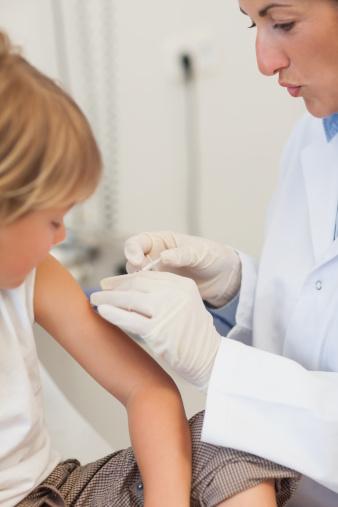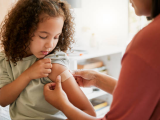A new study on flu vaccine effectiveness for the 2015-16 season in the United States found that the vaccine in general helped cut the risk of flu modestly, but a change in the 2009 H1N1 vaccine strain didn't fix the problem with the inhaled vaccine's effectiveness in children.
Scientists who are part of the Influenza Vaccine Effectiveness Network (IVEN) reported their findings today in the New England Journal of Medicine. Their preliminary findings were among the data that the Advisory Committee on Immunization Practices (ACIP) considered last summer when—amid growing evidence of a lack of effectiveness in children—it pulled its recommendation for the live attenuated influenza vaccine (LAIV), or nasal spray vaccine, for the 2016-17 flu season.
In late 2016, researchers from Medimmune, which produces FluMist, the only US-approved LAIV, reported that their initial investigation into the decreased effectiveness of the vaccine, seen in the United States but not necessarily in other countries, found that reduced fitness of the H1N1 vaccine virus strains were the likely culprit, but that they were looking into other possibilities.
No LAIV protection
For the study, the research team enrolled patients age 6 months and older who were seen during the 2015-16 flu season at study-site clinics in Michigan, Pennsylvania, Texas, Washington state, and Wisconsin. Using a test-negative design, they estimated flu vaccine effectiveness as the odds of testing positive for flu in both vaccinated and unvaccinated people.
Of 6,879 participants, 19% (1,309) tested positive for flu, mostly 2009 H1N1 and influenza B. The overall efficacy of flu vaccines was 48% (95% confidence interval [CI], 41% to 55%), which the team said was in line with other seasons in which vaccine virus strains were similar to the circulating flu viruses.
For children ages 2 to 17 years old, inactivated flu vaccines (flu shots) were 60% effective (95% CI, 47% to 70%), but the researchers saw no effectiveness for the LAIV, which officially measured a not-statistically significant 5% (95% CI, -47% to 39%). When the investigators looked at effectiveness against just the 2009 H1N1 virus in kids, inactivated vaccines were 63% effective. compared with -19% for LAIV.
Possible clue to LAIV mystery?
Flu vaccine experts have been puzzling over the lack of effectiveness for LAIV, which first became apparent during the 2013-14 flu season. The findings marked a dramatic turnaround from the vaccine's superior performance in younger children before the 2009 H1N1 pandemic, which led ACIP preferential recommendation for that age-group that it then revoked in early 2015.
In their analysis of the latest effectiveness findings, the researchers said estimates have varied widely among studies in the United States and Europe, but that all seem to show much higher effectiveness for inactivated vaccines. They noted that reasons for wide variations are unclear, especially since LAIV used in the United States, Finland, and United Kingdom was produced by the same company at the same plant.
Though the variations among country findings for LAIV could be due to chance, given relatively wide confidence intervals, researchers pointed out that vaccination history in US children is probably different than for European youngsters.
Young children in the United States had been recommended to get at least one dose of inactivated flu vaccine before age 2, followed by LAIV in the following years. UK health officials, in contrast, recommend flu vaccination for healthy children begin at 2 years of age using LAIV. And many children in a study from Finland had never been vaccinated against flu.
Though US children differed in the number of earlier vaccine doses and in the formulation of their first vaccine dose, earlier studies weren't powered enough to explore the issue in more detail, the group wrote, noting that they also saw discrepant results in US studies.
Michael Jackson, PhD, MPH, the study's first author and associate investigator at Kaiser Permanente Washington Health Research Institute in Seattle, said US children's exposure to a different sequence in flu vaccine formulation would only partly explain the poor effectiveness in the 2015-16 season, since it didn't perform as well as inactivated vaccines in any of the other studies.
Data on previous-year vaccinees, quadrivalent vaccine
Other patterns also stood out when the team analyzed the findings. They found that, as in previous seasons, vaccine effectiveness among those vaccinated the previous season was lower than those who hadn't, but the difference wasn't statistically significant.
Over the past few flu seasons, some research groups have found that prior-year flu vaccination might diminish performance of seasonal flu vaccines, but so far a mechanism for the effect hasn't been identified.
The researchers also found that quadrivalent (four-strain) inactivated vaccines were significantly more effective than the trivalent (three-strain) versions against the influenza B Victoria lineage, which wasn't targeted by the trivalent vaccines. They noted that, in some seasons, the trivalent vaccine seemed to protect against both influenza B lineages.
The findings suggest that switching to a quadrivalent inactivated vaccine may indeed prevent more influenza B infections, they wrote. "This idea needs to be tested."
The findings seem to raise more research questions as experts continue to tease out performance differences among the different flu vaccine formations and reasons for the drop-off of LAIV protection in US children.
"There's always more to learn about influenza vaccines, especially as new vaccine products get added to the market," Jackson said.
See also:
Aug 10 N Engl J Med abstract
Jan 11, 2016, CIDRAP News story "Studies note nasal spray vaccine failure against H1N1 flu"
Jun 22, 2016, CIDRAP News story "ACIP recommends against inhaled flu vaccine for next season"




















